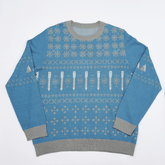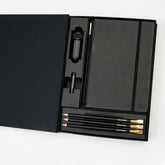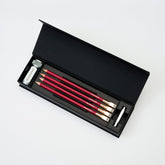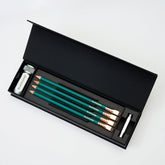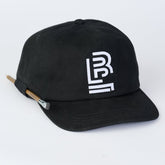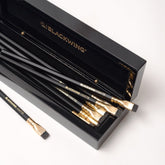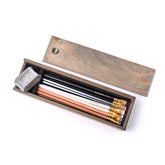The Process Behind the Blackwing 1138
Blackwing Volume 1138, behind the design
Last week, we unveiled the Blackwing 1138. If you haven’t already checked it out, read the scoop here. This post will make a lot more sense if you do.
With the reveal, the focus was on what was on the pencil; how we took the entirety of Georges Mélies’ A Trip to the Moon and fit it on a pencil. Today, we’re going to look at how we got it on the pencil.
Pencils that feature a full graphic image are usually created using a process called “wrapping.” Using this process, the graphic is printed onto a thin plastic material, and that material is wrapped around the barrel of the wood pencil. The result is a pencil with a tangible seam where the two ends of the wrap meet, and a graphic that is prone to flaking and lifting. The wrapping material can also damage some pencil sharpeners. In other words, wrapped pencils just aren’t our style.
Instead, we opted for a process known as roll-on printing to get the movie on each pencil. Roll-on printing has been around for a while (in fact, a similar process was used to achieve the gradient in Volume 725), but the thin bands of grays and blacks in the movie barcode demanded a level of precision that is difficult to achieve with a roll on printing machine. It took a bit of trial and error, but the result is a pencil we’re proud to put the Blackwing name on.
In the first step of this process, the unfinished pencils are coated with a white lacquer. This acts as a primer, making the pencil receptive to the final image. In fact, as you sharpen your 1138, you may notice a thin white line peaking out towards the tip of the pencil. After the white pencils dry for 24 hours, they are thoroughly cleaned to remove any dust or debris.

Then, the magic happens. The lacquered pencils are placed into a hopper, which feeds into the roll-on printer. One by one, the pencils pass through the print boards. As the pencil passes by each print board, the pencil is rotated and ink is applied directly to the barrel. While the pencil rotates, print board rotates in the opposite direction at the exact same speed, allowing us to print a continuous image all the way around the barrel of the pencil.

Roll-on printers are adept at printing large swatches of color and bold, isolated images and text. The image on the Blackwing 1138 doesn’t fall into either of those categories so, every 500 pencils, we stopped the machine, cleaned the print boards, and adjusted the feed to ensure everything was lined up properly.

Once the image is printed, the pencils are arranged in a single layer and allowed to dry for another full 24 hours. Even after this drying period, however, the ink is not fully set. To lock the image in place, a clear-coat lacquer is applied, and the pencils are allowed to dry for yet another 24 hours. That’s 72+ hours per pencil.
Once the clear-coat is dry, the pencils are sent off to receive their foil imprint, and prepared for finishing.

